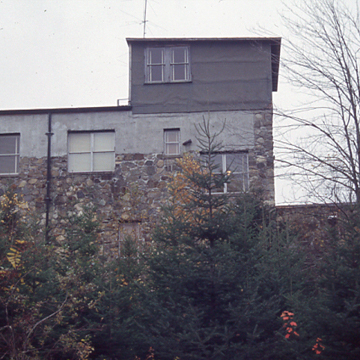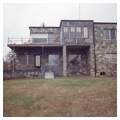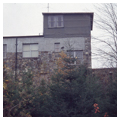You are here
Wilhlem Reich Museum
The Orgone Energy Observatory was built in 1948–1950 for Wilhelm Reich (1897–1959), a member of Sigmund Freud’s inner circle who was regarded as one of the most radical figures in the history of psychiatry. In 1941 Reich purchased 280 acres of land on the former John and Lincoln Ross Farm in Rangeley, where he built his home and laboratory named Orgonon. The impressive main building faces east, overlooking Dodge Pond, west of Rangeley Village. Modernist in design, the observatory is the creation of New York architect James Byron Bell. It was built by the contractor S.A. Collins and Sons using local fieldstone.
The facade consists of a sequence of projecting and receding wall surfaces. A stone terrace surrounds the building. The northern facade features a picture window on each story. Steel columns and a concrete pipe support a mid-story deck, which composes a third of the facade; a pipe railing protects the edge of the deck. The primary entrance is located on the south side elevation and is accessed via a long double flight of stone steps with a pipe hand railing. A two-leaf door is slightly inset within the deeply recessed wall. Mounted over the entrance is a bronze replica of the Reich’s symbol for orgonomic functionalism.
To the west of the entrance bay is the projecting wall of the main block that contains the flues for the house’s two interior fireplaces. Attached to the northwest corner of the roof is a shed-roofed frame enclosure sheathed in board-and-batten siding. This structure was built on what was originally intended to be an astronomical observatory. It was never installed and the space became a study instead. Reich’s laboratory occupied most of the first story, which had a large stone fireplace on the west wall. The second fireplace sat directly above it upstairs. The second floor contained a bathroom, an office, a main living room, a bedroom, and a storage closet.
Born in Austria in 1897, Reich was an officer in the Austrian Army during World War I and then graduated from the University of Vienna with a medical degree in 1922. In the 1920s he gravitated toward the new discipline of psychoanalysis, directing Freud’s psychoanalytic outpatient facility in Vienna until the two parted ways in 1931. Reich attempted to reconcile Freudian psychoanalysis with Marxism by tracing neuroses to both sexual and socio-economic conditions. His book The Mass Psychology of Fascism (1933) was banned and burned by Adolf Hitler and Reich fled Vienna, ultimately ending up in the United States in 1939, at the invitation of the New School in New York. Shortly afterward Reich discovered “Orgone” (a conflation of orgasm and organism), a term describing the biological (or cosmic) energy that he believed flowed through the human body and could be accumulated for therapeutic use. Reich created orgone accumulators comprising alternating layers of organic (plywood, cotton) and inorganic (steel, coal, sheet metal) materials, to better pursue scientific research on orgone.
His orgone research and promotion aroused bitter criticism. The press branded it “a fraud of the first magnitude,” and the Food and Drug Administration (FDA) obtained an injunction against the interstate shipment of orgone accumulators. In 1956 the FDA charged Reich with contempt for violating its injunction and sent him to serve two years at the Lewisburg Federal Prison in Pennsylvania, where he died a year later.
Orgonon is now home to the Wilhelm Reich Museum, with the Orgone Energy Observatory containing the majority of the museum’s exhibits.
References
Ledue, Joe. “Wilhelm Reich: A Short Biography.” Wilhelm Reich Infant Trust. http://wilhelmreichtrust.org/.
Mahoney, Kirk, “Orgone Energy Observatory,” Franklin County, Maine. National Register of Historic Places Inventory-Nomination Form, 1998. National Park Service, U.S. Department of Interior, Washington, D.C.
Writing Credits
If SAH Archipedia has been useful to you, please consider supporting it.
SAH Archipedia tells the story of the United States through its buildings, landscapes, and cities. This freely available resource empowers the public with authoritative knowledge that deepens their understanding and appreciation of the built environment. But the Society of Architectural Historians, which created SAH Archipedia with University of Virginia Press, needs your support to maintain the high-caliber research, writing, photography, cartography, editing, design, and programming that make SAH Archipedia a trusted online resource available to all who value the history of place, heritage tourism, and learning.



















